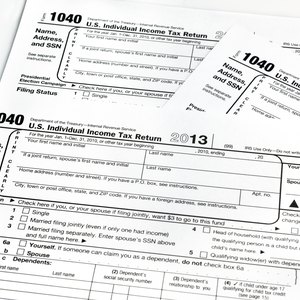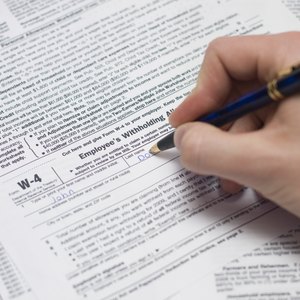
Before you start work for an employer and for future years after that, you will need to update the W-4 form so that the employer withholds the correct amount of federal and state taxes from your pay. You want the information on the form to be correct so that you don’t owe any money to the federal and state governments when you file your tax returns for the year. The W-4 form information is used with federal and state tax tables, which feature a "married" or "single" section with the number of allowances. The higher the allowances, the lower your tax liability. Allowances are what you are allowed to claim to reduce your tax liability.

Enter "1" allowance for yourself. If you are married, you can claim "1" allowance for your spouse on line C. By entering "1" for yourself and “0” for a spouse, the employer will use the tax table for a single flier and if you enter “1” for a spouse, the employer will use the tax table for a married person, which will have a lower tax liability.

Enter “1” on line B if you only have one job and you are single. If you have two jobs, you will enter “0” on this line. If your spouse works, enter “0” on this line or enter “1” if your spouse does not work. If your income from the second job or a spouse’s job is less than $1,500, you can enter “1” on this line.

Enter allowances for each dependent that you have. If you have three children or qualifying dependents, enter that number for additional allowances. If you have no children or dependents, you would enter “0.”

Enter “1” on line E if you will claim head of household on your tax return. If you have more than $1,800 in child care expenses, enter “1” on line F. On line G, you can enter “1” or “2” for each child that you have who is a qualifying child for the child tax credit, depending on your total income for the year.

Enter the total of lines A to G on line H and on line 5 of the W-4 form that you will hand to your employer. The employer uses the line 5 allowances to find your tax liability in the tax table under your filing status. You can have an additional amount of money withheld from your paycheck, but this is unusual for most people. If you owe back taxes, you can always have an additional amount withheld so that it can be applied to the back taxes when the federal or state governments take your refunds. However, people who are unsure of how much their tax liability will be or unsure of their total income for the year, can also have an additional amount withheld.

Claim exempt status if you did not have a tax liability the previous year or you were entitled to a full refund and if you expect the same tax liability for the current tax year. Exempt will mean that no taxes are withheld from your pay. Take your projected income for the year, subtract the deductions and credits on a 1040 form to determine if you will have a tax liability. Be very careful when claiming “Exempt” because if something changes, you could owe money to the government.
Tips
If you are unsure if you should claim an allowance, use the worksheet on page two that accompanies the W-4 worksheet and form.
Warnings
Never claim more allowances than what you are entitled to or you could owe the government.
References
- IRS: Publication 505 Tax Withholdings
- IRS: W-4 Form
- Internal Revenue Service. "Topic No. 753 Form W-4 – Employee's Withholding Allowance Certificate." Accessed Dec. 7, 2019.
- Internal Revenue Service. "Tax Trails - Can You Claim Exemption from Withholding on Form W-4?" Accessed Dec. 7, 2019.
- Internal Revenue Service. "Publication 501 (2018), Dependents, Standard Deduction, and Filing Information." Accessed Dec. 7, 2019.
Tips
- If you are unsure if you should claim an allowance, use the worksheet on page two that accompanies the W-4 worksheet and form.
Warnings
Writer Bio
Pamela Gardapee is a writer with more than seven years experience writing Web content. Being functional in finances, home projects and computers has allowed Gardapee to give her readers valuable information. She studied accounting, computers and writing before offering her tax, computer and writing services to others.

